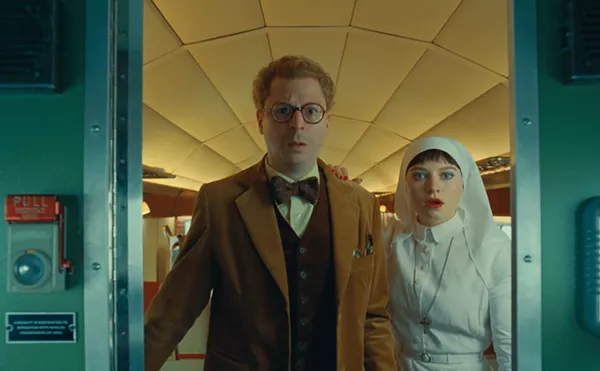There's not really a voice-over or soundtrack to this misguided group exhibition. It just feels like it. Much of the work on display is so in-your-face aggressive that you can almost hear a John Philip Sousa march playing in the background. And several works allude, with varying degrees of directness, to "The Star-Spangled Banner," which could easily be piped into the gallery on a continuous loop as theme music, although that might prove disruptive to the branch of the Broward County Library that's under the same roof as ArtServe.
The product being pitched here, of course, is patriotism, and the show is obviously timed to capitalize on the frenzy of flag-waving that accompanies Independence Day in America. A handout features an outline of the head and torch of the Statue of Liberty superimposed over the flag, and apparently the entertainment for the show's opening reception was tap dancing, which strikes me as more surreal than patriotic. It's enough to make you wonder if the refreshments included apple pie served by somebody's mom.
Draping oneself in the American flag to sell something is hardly new. But an exhibition with a patriotic theme seems to bring out the worst in a lot of artists. Some, I suspect, slap an appropriate title on an existing work to qualify for inclusion. Others think that a flag or two (or six or seven) worked into the imagery spells patriotism, case closed.
It doesn't help that the very idea of "A Salute to America" is so broad and general that it's all but meaningless. That probably explains why the exhibition is all over the map. Did the curator, identified on the handout only as "Vee," have specific criteria for deciding what to display? If so, whoever it is is keeping them to himself. How else to account for such a bafflingly assembled batch of art?
Not surprisingly, a lot of the topical material wrestles with 9/11. There's nothing wrong with that per se, although such a traumatic defining moment in American history may still be too raw for many artists to make sense of. (One of the only ones I can think of who successfully pulled it off is local artist Matt Carone, and he did it by way of abstraction.) A couple of color photographs early in the show, by Judy Lawne, offer powerful documentation of the horror, but they're really photojournalism rather than art. Elizabeth Perry's oil painting Nine/Eleven is a more ambitious attempt, although ultimately a disastrous one. The bottom portion of the canvas is devoted to a clotted mass of gray bodies that conveys the sense of claustrophobia and chaos in the streets, which gives way above to the familiar shards of the twin towers against an eerily beautiful sky. But then Perry populates that sky with angels plucking people out of the air, and the whole image collapses in maudlin sentiment.
Most of the flag-based work here is just appalling, although a few artists seem to be reaching for something beyond the obvious. Trudy Kubler's moody watercolor Freedom, for example, gets lots of mileage out of the title and three stars in white floating on a sea of red and blue bleeding together. And George Gadson's trompe l'oeil color photo Made in America, which features more than a dozen older-model cars that appear to be real but are actually models set on a flag-draped table at a flea market, is a rich stew of commentary about our country. The same is true of Sharon Basile's Pieces of America, a mixed-media collage packed with such diverse, seemingly contradictory imagery that you'd be hard-pressed to pinpoint the artist's political affiliation, and that ambiguity is a plus.
Much of the most interesting art in the exhibition is only tenuously related to the notion of saluting America. Photographer Irwin Weintraub, whose work is often a highlight of group shows in the area, contributes a Clyde Butcher-style black-and-white swamp shot and a couple of manipulated images printed on canvas, one of a rose and another of a flamingo. (The latter would have fared especially well paired with Elaine Roy's straightforward acrylic rendering of a flamingo.) Another photographer, Jeremiah Jenner, fizzles with a routine fireworks shot but sizzles with Childhood, an enormously evocative shot of a Tilt-a-Whirl sign against a twilight sky.
Venezuelan Jose "Pepe" Tortosa succeeds with Rockets Red Glare, an acrylic-on-wood construction that also works because of its indirectness. And Philip Kinbar's painting South Florida Clouds deftly balances the literal and the poetic with its cursory subject matter surrounded by stenciled lettering -- "o beautiful for spacious skies, for amber waves of grain" -- that's reminiscent of the work of Ed Ruscha.
Perhaps the best work in the show is a pair of underwater photographs by Philip Ross Munro, who has stolen at least one other ArtServe exhibition in the past year or two. In The Barracuda, the title creature is subsidiary to an enigmatic nude woman posed nonchalantly in the cloudy water in what looks to be a coral reef community. French Laundry, on the other hand, is a sort of underwater variation on a still life, with some unidentifiable garments drifting in the same sort of environment. Munro somehow manipulates the colors in these images so that some of the items take on an otherworldly glow that's fascinating, regardless of whether the photos have any connection to the show's stated theme.
Unfortunately, "A Salute to America" as a whole is cynical and contrived, with no apparent point other than to encourage more mindless flag-waving. And ironically, the exhibition comes at a time when the United States Congress is wasting time and money debating the constitutionality of flag burning as a means of protected expression, even as the unwitting disrespect of the American flag by well-intentioned artists is celebrated in a show as silly as this one.







